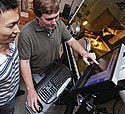Stronger Implants Layer by Layer
November 1, 2009
R&D DIGEST
|
Purdue researchers Shaoyi Wen (left) and Andrew Hecht work with a technology that is involved in the laser deposition process. Photo courtesy of PURDUE UNIVERSITY/ANDREW HANCOCK. |
Researchers from Purdue University (West Lafayette, IL) are projecting the need for hip and knee implants to double between 2010 and 2030. A team at the university is tasked with creating implants that last longer than current devices to address the anticipated increase in demand.
According to Yung Shin, professor of mechanical engineering at Purdue, implants have an average life span of 10 years. Some patients require three or four replacements in a lifetime.
The technology developed at the university involves a process called laser deposition. The method deposits layers of a powdered metal and ceramic mixture, which is melted with a laser and solidified one layer at a time to create a part. The method is cost-effective because there is no requirement for a mold, and orthopedic implants can be manufactured 10 times faster than current methods allow. During the development process, imaging scans are sent to a lab. The laser creates the part from the images. The process enables the manufacture of customized and complex parts.
According to Shin, laser deposition creates a porous titanium surface and a calcium phosphate outer surface, which mimics the stiffness of bone better than traditional implants. The process is especially suitable for coating titanium.
“Titanium and other metals do not match either the stiffness or nature of the bones, so you have to coat it with something that does,” says Shin, who is also the director of Purdue's Center for Laser-Based Manufacturing. “If you want to deposit ceramic on metal, you don't want there to be an abrupt change of materials, because that causes differences in thermal expansion and chemical composition, which results in cracks.”
The laser deposition process remedies this problem by gradually layering the material. Before they're ready for the commercialization stage, the team at Purdue will need to conduct more research. They plan to work with shape-memory materials that have a self-healing capability as well.
Copyright ©2009 Medical Device & Diagnostic Industry
About the Author(s)
You May Also Like


.png?width=300&auto=webp&quality=80&disable=upscale)
